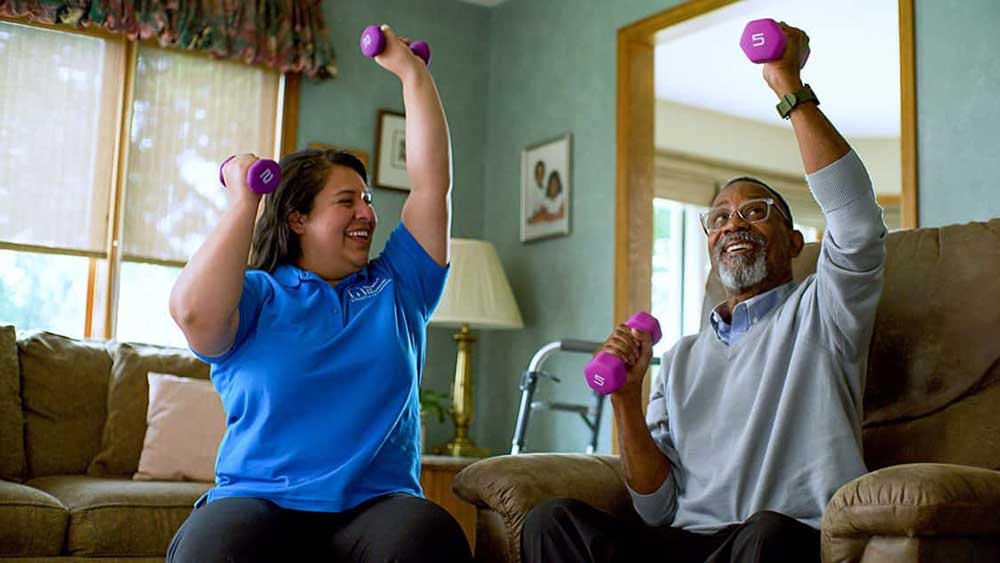

How to Improve Mobility During Your Senior Years
As we reach our senior years, exercising is a key ingredient to staying healthy, maintaining independence and living longer. People age 65 and older may think a leisurely walk around the block with the dog every day is enough—after all, it is exercise. Although any exercise is good, a walk with the dog is not enough.
According to the Centers for Disease Control and Prevention (CDC), regular exercise is one of the most important things older adults can do for their health. Lack of exercise can lead to health problems such as diabetes, cancer, heart failure, mental decline and poor mobility.
So, if you are a senior, or a caregiver of an elderly adult, and decide an exercise routine is a smart idea, where do you start? All worthwhile endeavors start with a plan, and all good plans have goals. The National Institute on Aging recommends relating your goals to the following four categories of exercise:
- Endurance – exercises that improve the heart, lungs and circulatory system
- Strength – exercises that build muscles in the arms, legs, back and hips
- Balance – exercises that prevent falls, which are common in seniors
- Flexibility – exercises to help you move freely
Important: Before you start any type of exercise program, be sure to discuss your plan with your doctor.
Endurance
If you have not been exercising routinely, start with short-term goals. For example, build your endurance with a 15-minute walk at your normal pace and gradually increase to a brisk walk or jog for longer distances. Join a dance or workout class for seniors at your local gym. Take a swim three days a week at your YMCA. Slowly build your endurance, increasing the intensity of your exercise as you go.
Strength
Strength is significant to maintaining independence as you age. You can strengthen your arms by using hand weights. Graduate to heavier weights as your strength increases. There are plenty of resources online that provide hand weight workouts for seniors. Strengthen your core by lying on your back with your knees bent and raising your hips off of the floor; hold to the count of 10. Do sit-ups. Hold on to the back of a chair and do squats to build muscles in your legs. Pick up a tennis ball and give it a squeeze.
Start by doing each of your strength exercises at a minimum of 10 reps and move up to at least 12 to 15 reps of each. You can find strength-building routines for seniors on YouTube.
Balance
Falls are the leading cause of injuries in seniors in the U.S. Strengthening and maintaining your balance should be an important part of your exercise plan. Some balance exercises are simple and can be done throughout the day such as standing on one foot, making sure you have something to hang on to if you start to fall; or walking in a straight line by putting one foot directly in front of the other.
Joining a yoga class or tai chi group will help you with balance and is a great way to hang out with friends, make new friends, or simply get a change of scenery.
Flexibility
Flexibility is vital to accomplishing everyday tasks such as tying our shoes, looking over our shoulder while backing up the car, reaching for a glass on the top shelf, and drying our back when we get out of the shower. Some examples of flexibility activities include standing with your legs spread slightly and twisting your neck to look over your shoulder; bending at the waist and reaching for your toes; and standing up straight, raising your hands and stretching to the sky.
Ankle and back-of-leg stretches help us go up and down stairs, get out of bed, and get up off of the floor. Here are two stretches to try: While sitting on a straight-back chair with your hands planted firmly on the sides of the seat, stretch your legs forward with your heals on the floor and point your toes down and then up. Stay seated with your legs stretched forward and raise your legs off the floor. Hold each exercise to the count of 10.
How Much Exercise Is Enough?
The CDC recommends working up to 150 minutes a week of moderate-intensity activity, with two days a week building your endurance and strength, and three days a week of balance and flexibility activities.
How Old Is Too Old To Exercise?
The answer is you are never too old. A recent study by the AARP and National Geographic magazine found that the effort to increase physical stamina among seniors age 60 to 80+ steadily rose with 73% of seniors in the 80+ group working to maintain it.
There are many myths about exercise and age, such as “physical fitness decline in old age is inevitable” and “you can’t build muscle after a certain age.” Not true, according to Dr. Edward Phillips, Assistant Professor of Physical Medicine and Rehabilitation at Harvard Medical School. “Even people 100 years old can build muscle strength,” says Dr. Phillips.
A Right at Home caregiver can provide supervision as you complete a regular exercise program approved by your doctor. The caregiver’s presence allows you to feel confident as you exercise, helping you stay healthy and maintain your independence. Use our location finder to contact your local Right at Home today and ask for a FREE in-home consultation.







